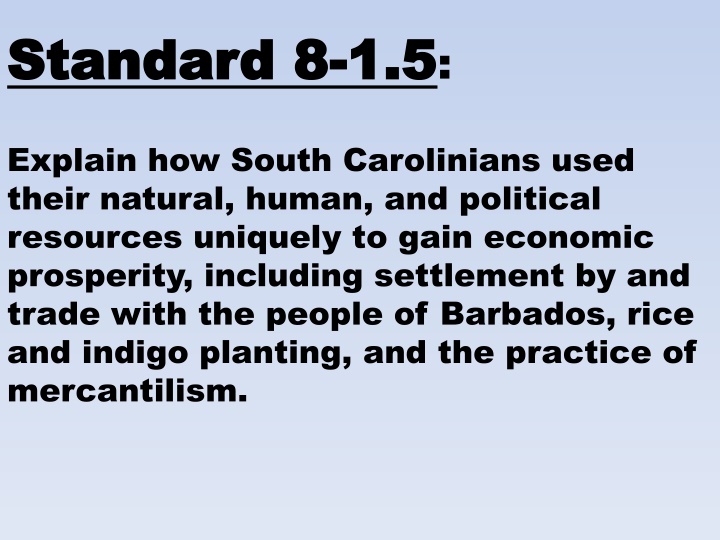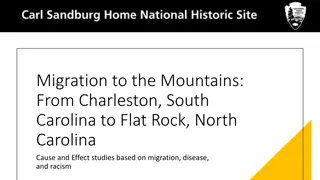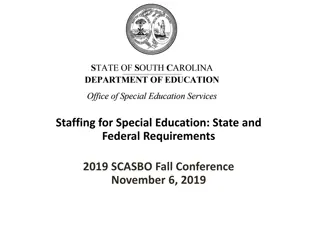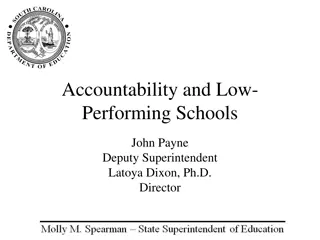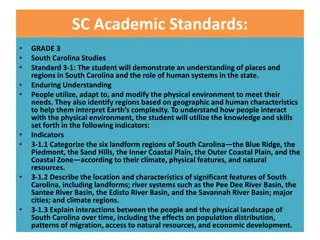South Carolina's Economic Prosperity Pathways
South Carolinians capitalized on their unique natural resources, human labor, and political strategies to achieve economic success, including trade with Barbados, rice and indigo cultivation, and the adoption of mercantilism. The utilization of African slaves for rice cultivation, Eliza Lucas Pinckney's indigo cultivation, and trade partnerships were key factors in their prosperity.
Download Presentation

Please find below an Image/Link to download the presentation.
The content on the website is provided AS IS for your information and personal use only. It may not be sold, licensed, or shared on other websites without obtaining consent from the author.If you encounter any issues during the download, it is possible that the publisher has removed the file from their server.
You are allowed to download the files provided on this website for personal or commercial use, subject to the condition that they are used lawfully. All files are the property of their respective owners.
The content on the website is provided AS IS for your information and personal use only. It may not be sold, licensed, or shared on other websites without obtaining consent from the author.
E N D
Presentation Transcript
Standard 8 Standard 8- -1.5 1.5: Explain how South Carolinians used their natural, human, and political resources uniquely to gain economic prosperity, including settlement by and trade with the people of Barbados, rice and indigo planting, and the practice of mercantilism.
Key Skills Key Skills: Compare the locations of places, the conditions at places, and the connection between places Explain why trade occurs and how historical pattern of trade have contributed to global interdependence Evaluate multiple points of view or biases and attribute the perspectives to the influences of individual experiences, societal values, and cultural contributions
Key Key Vocabulary: Vocabulary: Carolina Gold Eliza Lucas Pinckney Indigo Subsidy Bounties Mercantilism Exports Imports Salutary Neglect Enumerated List Barbados/Barbadians
Natural Resources: 1. South Carolina s natural resources included: 1. Deer Food & Skins 2. Pine Forests Timber and Sap for Navel Stores 2. South Carolina also had: 1. Fertile Land 2. Mild Climate 3. Long Growing Season. 3. Geographic conditions in the Lowcountry made it suitable for rice planting. 4. A port at Charleston and navigable waterways made shipping goods to market possible.
Trade: Trade: 1. Aided by trade with the people of Barbados 2. Natural Resources = Flourishing Trade = Profitable Colony 3. Initially, traded furs and deerskins with Native Americans for beads, trinkets, guns, and alcohol A. Native Americans forced into slavery = relationship ended 4. Some Carolina settlers from Barbados A. Established a thriving trade with this Caribbean Island B. Sold cattle and Native American slaves to Barbados 5. Pine Trees = source of pitch and tar (naval stores) A. British used for making ships watertight.
Slave Influences: 1. African Slaves had knowledge: Rice Cultivation and Cattle Herding 2. Rice became known as Carolina Gold a staple crop and long-term prosperity 3. Growing Agricultural Economy: Determined settlers Hard Work of Slaves
Eliza Lucas Pinckney: successfully cultivated Indigo as a Cash Crop Planted Indigo to make family plantation successful. Indigo used to make a highly valued blue dye. The British government offered a subsidy (or bounties) as an incentive to anyone who would grow it.
Political Factors: 1. Mercantilism A. Mother Country controlled trade B. Favorable Balance of Trade (export more than import) C. Amass more gold and silver (Bullion) = wealthy and powerful. 2. South Carolina --> (British Mother Country) A. Source of raw materials B. Market for manufactured goods. Mother Country = Less Dependent on Foreign Trade = Improved Balance of Trade = Wealth
Colonial Carolina was: 1. A Source of Raw Materials 2. A Market for the mother country (England) Mother Country: (England) 1. A secure market in which the rice planters could sell their crops
Enumerated List: 1. List of Products that could be sold only to England A. Rice and Indigo from SC B. British Government did not enforce on Rice -Giving S C economic advantage wider market Salutary Neglect: 1. British Government didn t enforce most mercantilist laws A. British North America developed economies without much interference from the mother country.
Primary sources Compare and contrast a bill of sale and a contract of indenture servant. Determine what source of labor they would use if they would use if they were a plantation owner. http://www.teachingushistory.org/lessons/early_ labor.htm http://ricediversity.org/outreach/educatorscorne r/documents/Carolina-Gold-Student-handout.pdf go to page 8, maps are at the bottom that compare the growth of rice and slave labor in South Carolina.
